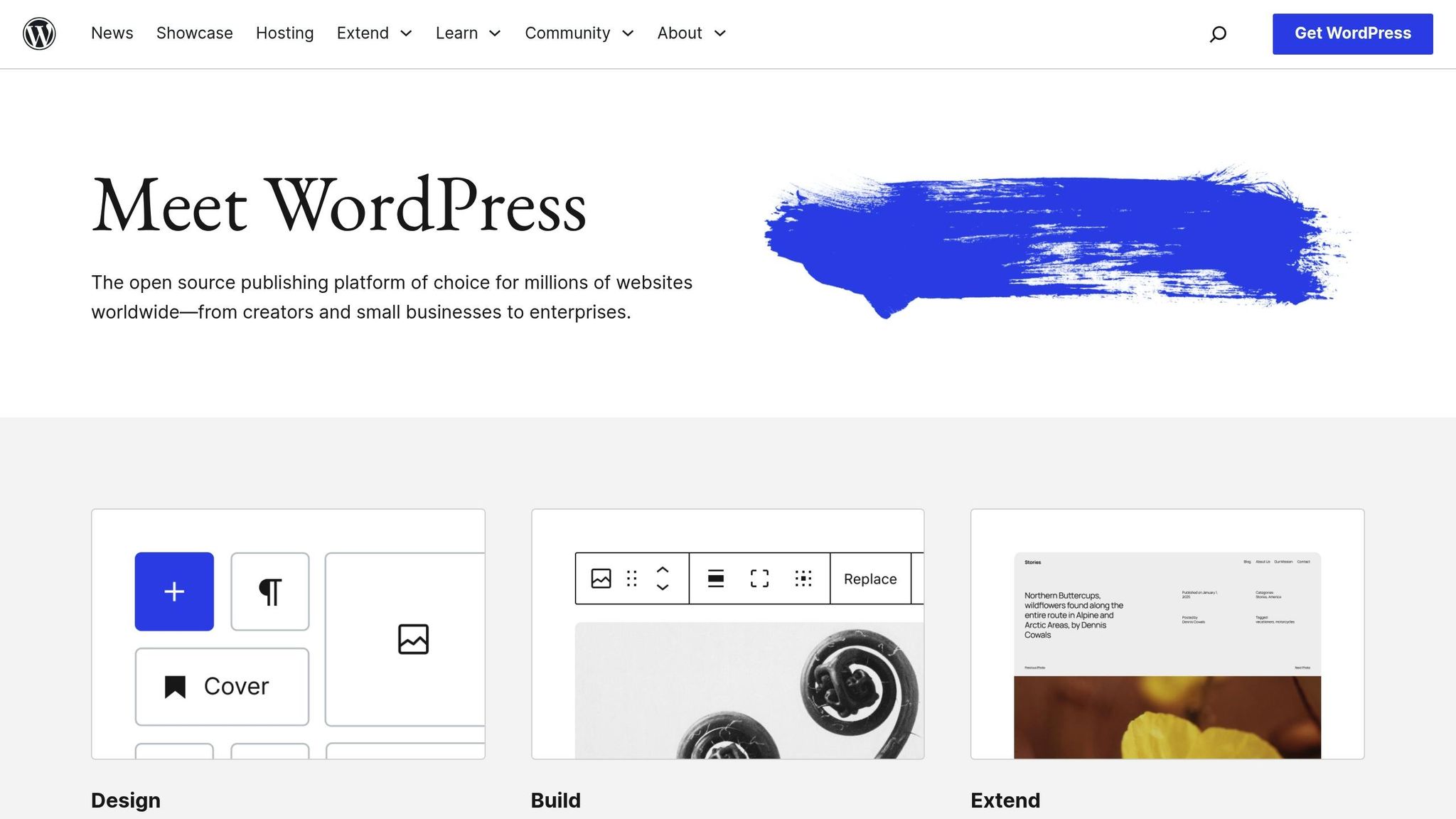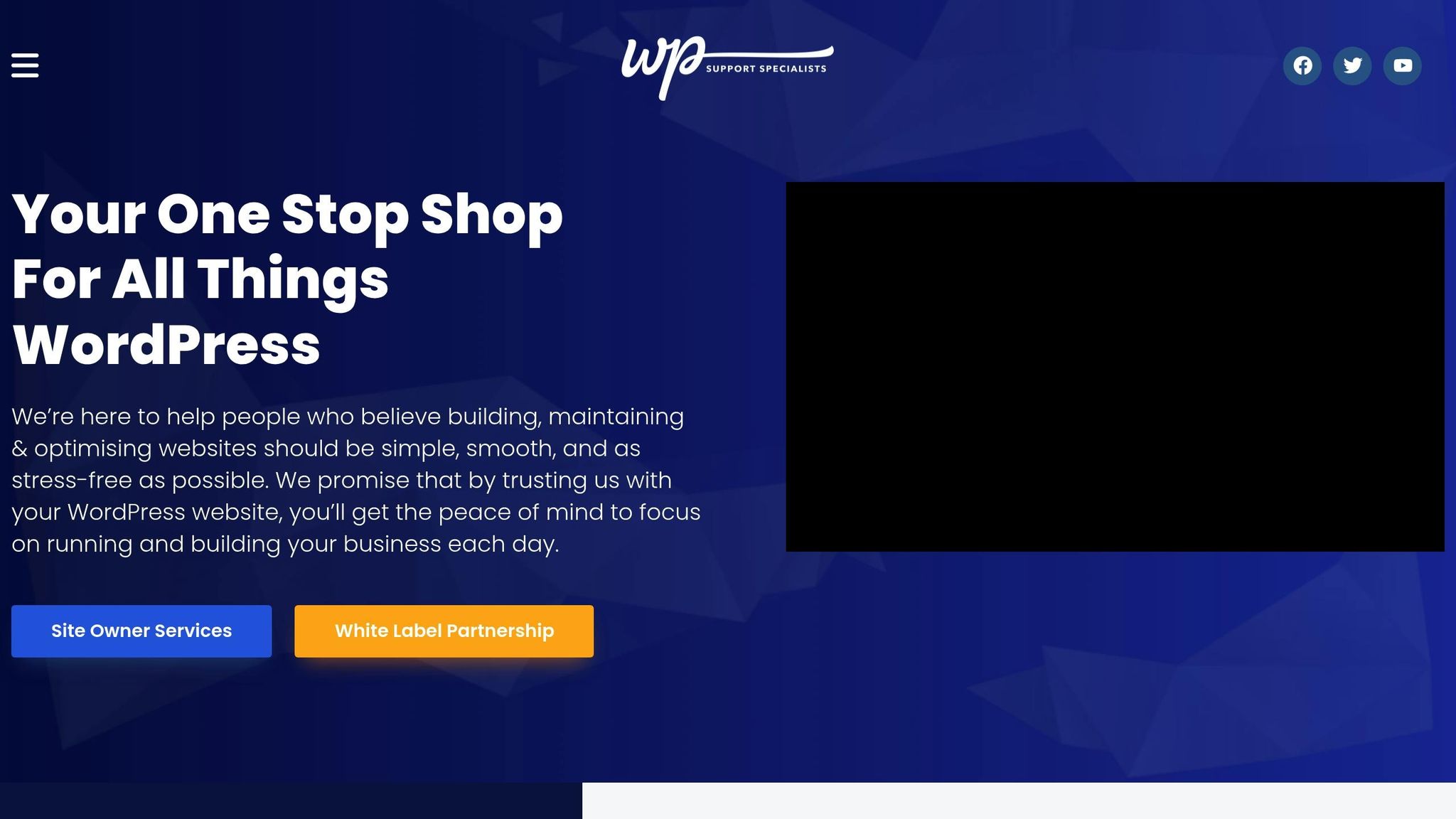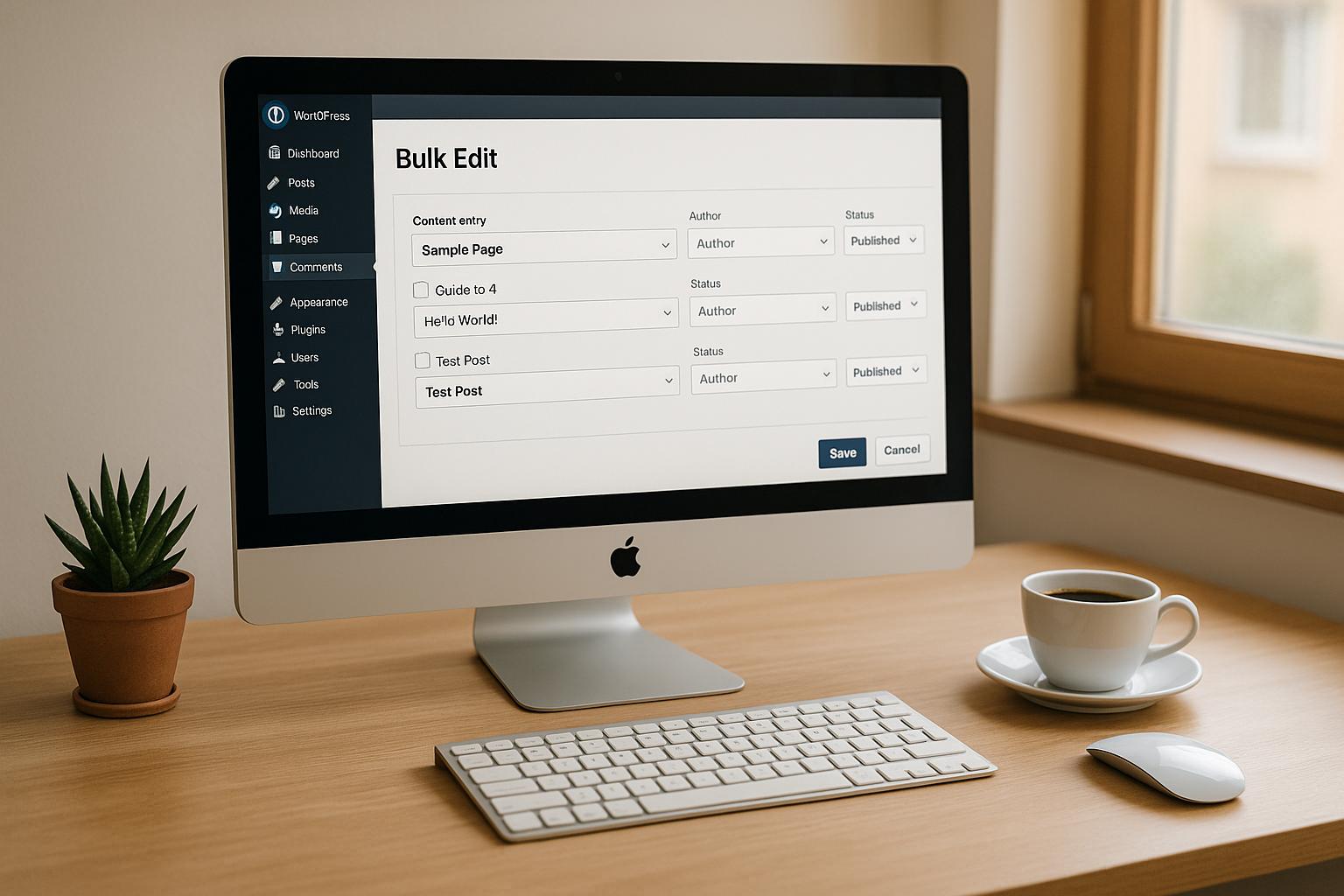Disabling unused features in WordPress is one of the simplest yet most effective ways to protect your site from attacks. Features like XML-RPC, file editing, and inactive plugins can act as entry points for hackers if left enabled. Research shows that 96.77% of new WordPress vulnerabilities come from plugins, and outdated or unused components are often the cause. By turning off unnecessary features, you reduce your site’s "attack surface", making it harder for attackers to exploit vulnerabilities.
Key Takeaways:
- Unused features increase security risks: Every active feature, even if unused, can be a target for attackers.
- Outdated plugins and themes are a major threat: Abandoned components are often unpatched and vulnerable.
- Simple fixes can protect your site: Disabling features like XML-RPC and file editing can block common attack methods.
- Regular audits and backups are essential: These steps ensure your site stays secure and functional.
Quick Fixes:
- Disable XML-RPC to prevent brute-force and DDoS attacks.
- Turn off file editing to block malicious code injections.
- Remove inactive plugins and themes to eliminate hidden vulnerabilities.
- Test changes in a staging environment to avoid disruptions.
- Always create backups before making updates.
Reducing unused features not only strengthens security but also simplifies site maintenance. If you’re unsure how to handle this, seek help from WordPress experts for audits and ongoing protection.
How to Harden Your WordPress Installation | Lesson 3

How Unused Features Create Security Risks
Every active feature in WordPress can act as a potential doorway for attackers. Think of it like a house with too many unlocked doors and windows – each one increases the chances of someone finding a way in. Even features you don’t use can pose risks if they remain active, as they still execute code that might contain vulnerabilities. And if these components aren’t monitored or updated regularly, the risks only grow.
Larger Attack Surface
The more features, plugins, or themes you have installed – even if they’re inactive – the larger your attack surface becomes. These components stay on your server and might contain exploitable code. In 2024, security researchers found 827 abandoned plugins and themes, highlighting how outdated features can quietly become a security threat. Additionally, new features can sometimes interact with existing ones in unpredictable ways, creating even more opportunities for vulnerabilities.
Common Features That Get Exploited
Some WordPress features are particularly attractive to attackers. Here’s a closer look at a few of them:
- XML-RPC
Originally created to help with mobile app publishing, XML-RPC has become a common target for brute-force login attempts and DDoS attacks. This is especially problematic if your site primarily uses the REST API instead. - File Editing Capabilities
WordPress’s built-in file editor allows administrators to modify files directly. If attackers gain admin access, they can use this feature to inject malicious code into critical files. - Embed Features
While embeds are useful for generating content previews, they can also be exploited to trigger unexpected server requests, creating another potential weak spot. - Inactive Plugins and Themes
Even if you’re not using them, inactive plugins and themes can still pose risks. For instance, a European media company experienced a breach when a delayed plugin update left a known vulnerability open. Attackers exploited it, defaced their homepage, and injected spam links for three days. - Backup Plugins and Unused File Upload Features
Backup plugins with exposed management endpoints have been used to gain unauthorized access to databases and files. In 2025, some commercial themes with unused file upload features allowed attackers to execute remote code, creating backdoors for persistent access.
Leaving unused features active is like leaving extra keys under the doormat – unnecessary and risky. Up next, we’ll discuss which WordPress features you should disable to improve your site’s security.
WordPress Features You Should Disable for Better Security
To tighten your WordPress site’s security, it’s crucial to disable certain features that, while useful in specific scenarios, can expose your site to unnecessary risks. Here’s a closer look at some WordPress features you should consider turning off to keep your site safer.
XML-RPC
Originally designed to enable remote publishing via mobile apps and third-party tools, XML-RPC has become a frequent target for cyberattacks. By default, this feature is enabled, making it vulnerable to brute-force attacks and DDoS exploits. These attacks often leverage the xmlrpc.php file to amplify traffic or repeatedly attempt logins.
If remote publishing isn’t something you use, disabling XML-RPC is a smart move. Simply add this line to your wp-config.php file:
add_filter('xmlrpc_enabled', '__return_false'); If you’re using managed hosting, check if your provider offers an option to disable this feature directly.
File Editing
The built-in WordPress file editor allows administrators to modify theme and plugin files directly from the dashboard. While convenient, it becomes a significant security risk if an attacker gains admin access – they can inject harmful PHP code, creating a backdoor to your site.
To disable file editing, add this line to your wp-config.php file:
define('DISALLOW_FILE_EDIT', true); This ensures that any file changes must be made through more secure methods, like FTP or a file manager.
Embeds
WordPress’s embed feature lets you display external content, such as videos or social media posts, on your site. However, this functionality can open your site to cross-site scripting (XSS) vulnerabilities, which make up nearly half of all plugin-related security issues.
To turn off embeds, include the following lines in your theme’s functions.php file:
remove_action('wp_head', 'wp_oembed_add_discovery_links'); remove_action('wp_head', 'wp_oembed_add_host_js'); This step reduces potential vulnerabilities tied to embedding external content.
Heartbeat API
The Heartbeat API supports real-time updates and autosave features during content editing by maintaining a connection between your browser and the server. While helpful, it can also be exploited to overwhelm your server with excessive requests, leading to performance issues or even downtime.
If you don’t rely on real-time updates, you can disable the Heartbeat API by adding the following code to your theme’s functions.php file:
add_action('init', 'stop_heartbeat', 1); function stop_heartbeat() { wp_deregister_script('heartbeat'); } Alternatively, you can limit the API’s frequency or disable it on specific pages to balance functionality and security.
Inactive Plugins and Themes
Even when not in use, inactive plugins and themes can pose a significant threat. They remain on your server and may lack critical updates, making them prime targets for attackers. Research shows that unmaintained plugins account for a large portion of WordPress vulnerabilities.
To minimize risks, follow these steps:
- Identify which plugins and themes are actively used.
- Deactivate any unused items to confirm they don’t disrupt your site.
- Permanently delete unused plugins and themes from your installation.
By removing these inactive components, you reduce potential entry points for attackers and simplify your site’s maintenance.
| Feature | Security Risk | Action Required |
|---|---|---|
| XML-RPC | Brute-force and DDoS attacks | Disable if remote publishing isn’t needed |
| File Editing | Backdoor creation after admin compromise | Add DISALLOW_FILE_EDIT to wp-config.php |
| Inactive Plugins | Vulnerabilities due to lack of updates | Delete completely from your site |
| Inactive Themes | Persistent security gaps | Remove unused themes entirely |
| Heartbeat API | Resource exhaustion attacks | Disable or limit its frequency |
Disabling these features not only strengthens your site’s defenses but also reduces the chances of performance issues and security breaches.
How to Safely Disable and Manage Features
Once you’ve identified vulnerabilities by disabling unused features, the next step is to manage these changes carefully to keep your site secure and stable. Security isn’t just about turning off unnecessary features – it’s about handling those changes in a way that minimizes risks and ensures your site remains functional. Taking a thoughtful, step-by-step approach can help you avoid costly downtime or disruptions.
Running Regular Security Audits
Security audits are your first line of defense. They’re essential for pinpointing which features, plugins, or settings could be putting your WordPress site at risk. These audits provide a full review of your site, uncovering vulnerabilities before attackers can exploit them.
During an audit, you might discover outdated plugins or themes that no longer receive security updates, abandoned extensions, incorrect file permissions, or unnecessary features that were enabled by default. It’s also important to scan for unexpected PHP files, altered file hashes, or new scheduled tasks – any of which could signal a compromise. A thorough audit should document every active and inactive plugin, theme, and core feature on your site. For instance, in 2025, researchers highlighted the risks posed by many abandoned WordPress extensions.
This process helps you prioritize what to disable based on vulnerability severity and potential impact. A surprising number of site owners don’t have an accurate inventory of their extensions, making effective management nearly impossible.
Professional security audits go a step further, offering detailed reports on vulnerabilities specific to your site. Skipping regular audits can leave your site exposed, often leading to bigger, more expensive problems later.
Testing Changes in a Staging Environment
Before making any changes to your live site, always test them in a staging environment. This is especially important when disabling features like XML-RPC, file editing, or the Heartbeat API. For example, turning off XML-RPC might disrupt legitimate third-party integrations or mobile publishing workflows your site relies on. Testing in a staging environment ensures that disabling a feature won’t unintentionally break something critical.
Removing plugins or themes can also affect how your site looks or functions. These changes might not always be obvious right away, but they can impact user experience or even your search engine rankings. Testing first allows you to catch compatibility issues, broken features, or unexpected behavior in a safe space, where mistakes won’t affect your live site or its visitors.
The best approach? Apply patches in staging, verify everything works as intended, and then roll out changes to your live site. Once you’re confident everything is stable, make sure to create a recovery point with a full backup before finalizing any updates.
Creating Backups Before Making Changes
Backups are your safety net. Always create a full backup of your site before making any changes, and store these backups in a secure, offsite location. This could be cloud storage or an external drive – anywhere that remains accessible even if your site is compromised.
Your backup should include both your database and files. For active sites, daily automated backups are a smart choice, while static sites may only need weekly backups. Regularly scheduled backups ensure you can restore your site quickly if something goes wrong.
It’s also a good idea to document every change you make, along with the date. This way, if you need to restore your site, you’ll know exactly what state it will return to. This documentation is invaluable when troubleshooting issues or planning future updates.
Considering that 96% of WordPress site owners have experienced at least one security incident, having a solid backup and recovery plan isn’t just a good idea – it’s essential for protecting your site and keeping your business running smoothly.
| Safety Measure | Purpose | Timeline |
|---|---|---|
| Security Audit | Identify unused features and vulnerabilities | Monthly |
| Staging Test | Ensure changes don’t disrupt functionality | Before each change |
| Full Backup | Enable quick recovery if issues arise | Before each change + automated schedule |
sbb-itb-976b402
Research Results: How Disabling Unused Features Improves Security
Research has consistently shown that turning off unused features can make WordPress sites much safer. Studies and security reports confirm a clear link between reducing active features and blocking potential attacks. This isn’t just a best practice – it’s a critical step in protecting your site. By limiting the features in use, you’re effectively closing doors that attackers might exploit.
Fewer Malware Infections
Security data highlights a striking trend: sites that disable unused features face far fewer malware infections. According to a 2024 Wordfence report, most malware infections stem from vulnerabilities in outdated or inactive plugins and themes – not the WordPress core itself. This means attackers are more likely to target forgotten components rather than WordPress as a whole.
For example, in 2024, researchers flagged 827 abandoned plugins with known vulnerabilities. These neglected plugins become easy prey for attackers since they’re rarely updated or monitored.
Real-world examples back this up. In 2025, the "Alone" theme’s remote install feature was exploited to upload PHP backdoors – but only on sites where the feature was still enabled. Similarly, abandoned contact form plugins with arbitrary file upload vulnerabilities led to widespread infections, as attackers targeted sites with these inactive but unpatched plugins.
On the flip side, sites that proactively removed unused or abandoned plugins saw a significant drop in successful attacks. This proves a direct connection between reducing unused components and improving security.
Less Damage During Zero-Day Attacks
Zero-day vulnerabilities – flaws that don’t yet have a patch – pose a serious threat. However, sites with fewer active features are less vulnerable because attackers have fewer options to exploit. For instance, when a zero-day flaw is discovered in a popular plugin, only sites with that plugin enabled are at risk. Sites that have already disabled or removed it remain safe.
This principle applies to more than just plugins. Features like XML-RPC, often targeted for brute-force and DDoS attacks, become irrelevant when disabled. Similarly, file editing capabilities that could allow code injection are no longer a threat if turned off. Other built-in WordPress features, such as the Heartbeat API and embeds, also represent potential attack points that vanish when disabled.
Survey data reinforces this. The 2025 Melapress Security Survey found that sites with fewer active features and a smaller plugin/theme footprint reported fewer and less severe security incidents. This demonstrates a strong connection between streamlined WordPress setups and reduced risk.
| Attack Vector | Risk When Active | Risk When Disabled |
|---|---|---|
| Unused Plugins | High – 90% of vulnerabilities | Eliminated |
| XML-RPC | Frequent brute-force target | No exposure |
| File Editing | Code injection risk | Cannot be exploited |
| Abandoned Themes | Unpatched vulnerabilities | Zero risk |
Nearly 96% of WordPress users have experienced at least one security incident, and 64% have faced a full breach. Yet, sites that keep their features to a minimum consistently fare better in these statistics. Even after vulnerabilities are patched, many sites remain exposed for weeks due to delayed updates. By disabling unused features, you eliminate this risk entirely.
Reducing your site’s active features limits the pathways attackers can use to infiltrate. This smaller attack surface not only makes your site harder to compromise but also minimizes the damage if an attack does succeed. For zero-day vulnerabilities, a lean WordPress setup means fewer opportunities for exploitation and less harm overall.
How WP Support Specialists Can Help

Keeping your WordPress site secure takes more than just basic precautions – it requires expert attention. WP Support Specialists offers a range of WordPress-specific services designed to protect your site while maintaining its performance. Their deep knowledge of WordPress allows them to tackle security challenges head-on, identifying potential risks and addressing them before they become issues. These services align with the best practices mentioned earlier, providing an extra layer of protection for your site.
Complete Security Audits
WP Support Specialists conducts detailed security audits that cover every aspect of your site. They review all plugins, themes, and core features, identifying inactive or unnecessary elements like unused plugins, outdated themes, XML-RPC functionality, and file editing options. After the audit, they provide actionable recommendations for safely removing or deactivating these components. Each item is also checked for known vulnerabilities and evaluated for its relevance to your site.
The audit results include a comprehensive report with a breakdown of vulnerabilities, their severity, and clear steps to fix them.
Here’s a critical stat: 97% of all new WordPress security vulnerabilities in 2023 were found in plugins. This highlights why managing features and plugins is so important for keeping your site secure.
Regular Maintenance and Monitoring
Once your site has been audited, keeping it secure requires ongoing maintenance. WP Support Specialists offers maintenance plans that include scheduled updates for WordPress core, plugins, and themes, along with continuous monitoring for new threats. Their services also include automated and manual backups, uptime tracking, and regular vulnerability scans.
Consider this: 58.9% of new vulnerabilities in 2023 didn’t require authentication to exploit. This makes unmaintained sites especially easy targets for attacks.
Their maintenance plans are flexible, starting at $78 per month for basic monitoring of simple websites and going up to $384 per month for advanced support tailored to complex e-commerce platforms. These plans emphasize proactive management to ensure unused features don’t pile up and create security risks.
For example, by the end of 2023, Sucuri scanners identified over 10,000 websites infected with malware due to a single plugin vulnerability. Sites under professional maintenance benefited from quick updates and preventative measures, reducing their exposure to such risks.
Custom Solutions for Businesses and Agencies
WP Support Specialists also develops custom solutions to address the unique needs of businesses and agencies. For sites with intricate setups, they offer advanced security configurations, custom authentication methods, and automated workflows tailored to your operations.
For agencies, they provide white-label services, allowing them to deliver branded WordPress security and maintenance solutions to their clients seamlessly.
Larger organizations can benefit from enhanced security measures, such as limiting access to sensitive features, setting up role-based permissions, and creating custom security protocols. They also provide guidance on best practices, like enforcing strong password policies and implementing two-factor authentication.
When standard plugins don’t meet your security needs, WP Support Specialists can develop custom plugins to close the gap. If malware is detected, they perform thorough scans to locate and remove infected files, restore clean backups if necessary, and strengthen your site by disabling weak or unused features. Afterward, they provide a detailed report with steps to prevent future issues.
Conclusion: Improve WordPress Security by Managing Features
Taking charge of your WordPress features isn’t just a tech-savvy move – it’s a critical step toward securing your site against potential threats. Here’s a stark reality: 90% of WordPress vulnerabilities come from plugins, while the core software accounts for only 4% of issues. The features you enable play a significant role in determining how secure your site truly is.
Studies highlight that websites with fewer active plugins and carefully managed features face fewer malware risks and are less impacted by zero-day attacks. Plus, staying proactive with feature management can save you from costly recovery efforts and even boost your site’s performance. These findings make it clear – adjusting your site’s configuration is not optional; it’s essential.
Start with the basics: audit your plugins and themes. Remove anything inactive or unnecessary. Features like XML-RPC? Turn them off if they serve no purpose for your site. And remember, always test these changes in a staging environment and back up your site beforehand.
If your setup feels too complex to tackle alone, don’t hesitate to seek professional help. WordPress security experts can guide you through the process of optimizing your site’s defenses.
FAQs
How can I identify which WordPress features to disable without impacting my site’s performance?
To figure out which WordPress features you can safely disable, start by assessing what your site actually needs to function properly. Features that aren’t being used – like inactive plugins, themes, or optional settings – are often safe to turn off without impacting your site’s performance. Just make sure to test any changes in a staging environment before rolling them out to your live site.
Prioritize disabling features that could create security vulnerabilities. For instance, you might want to turn off XML-RPC if it’s not essential, remove unused admin accounts, or get rid of outdated plugins. If you’re not entirely sure which features to disable, consulting a WordPress expert or performing a detailed security audit can help you make smart choices while keeping your site secure and running smoothly.
What risks come with leaving XML-RPC and file editing features enabled on my WordPress site?
Leaving XML-RPC and file editing features active on your WordPress site can open the door to potential security threats. XML-RPC, for example, is a common target for brute force attacks or DDoS amplification when left unsecured. On the other hand, the file editing feature, which allows direct access to theme and plugin files, can be exploited by hackers or unauthorized users to inject harmful code.
By disabling these features, especially if they’re not in use, you can significantly reduce your site’s vulnerability to attacks. Pair this with regular security audits to identify and address any risks, keeping your site safer from potential threats.
Why should I test changes in a staging environment before updating my live WordPress site?
Testing updates in a staging environment is a smart way to keep your live WordPress site running smoothly and securely. It gives you a safe space to experiment, letting you catch and fix problems – like plugin conflicts, broken features, or design glitches – before they affect your visitors or cause downtime.
Think of a staging environment as your website’s safety buffer. It lets you review updates, make customizations, or try out new features without the risk of disrupting your live site. This precautionary step helps maintain your site’s performance and protects its reputation.







